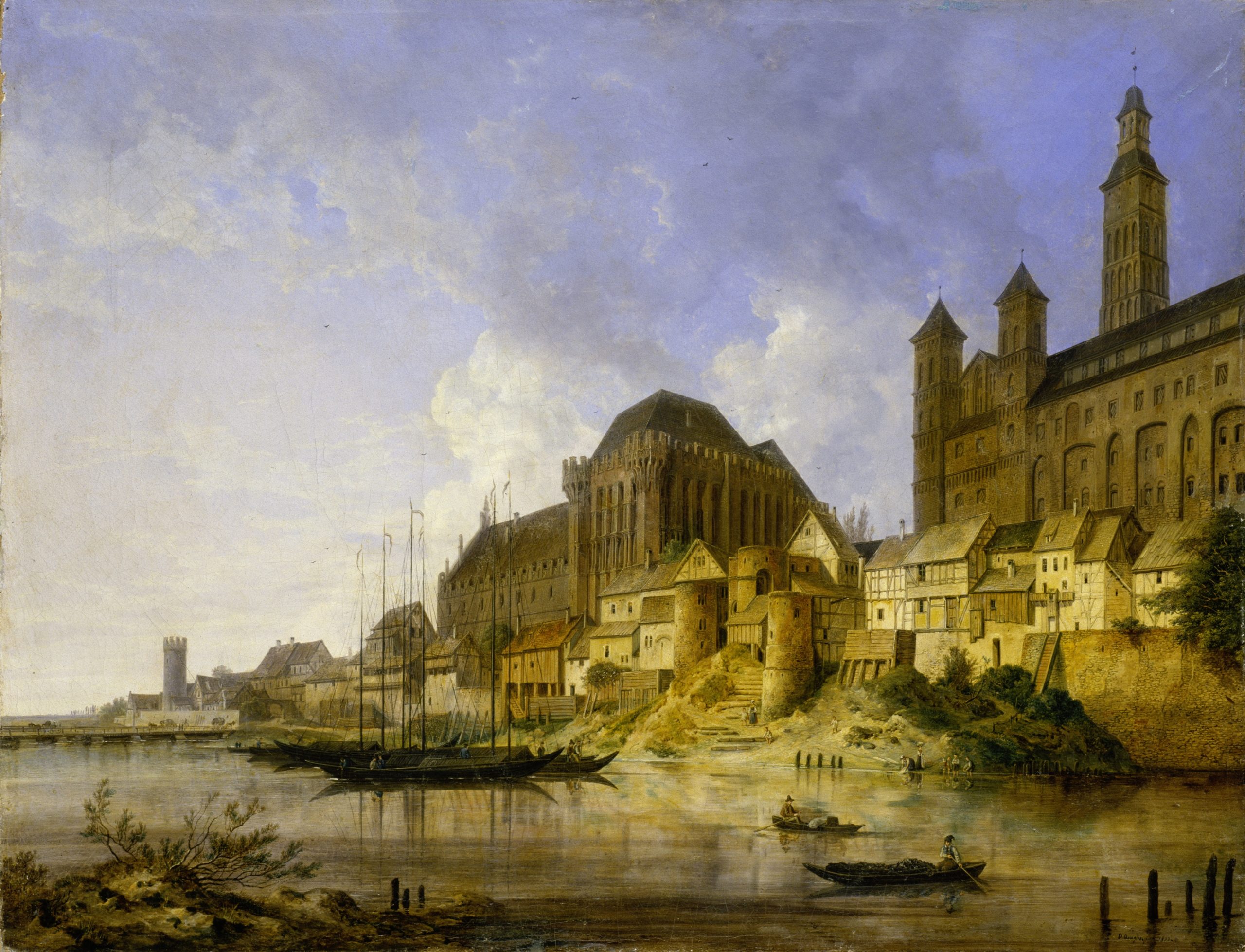Domenico Quaglio the Younger was born on January 1, 1787 in Munich in a family of artists with Italian roots (Laino), who settled in the Bavarian capital in the second half of the 18th century and was also its most outstanding representative [fig. 1]. He practiced theatrical scenery, landscape painting and veduta. He was a real connoisseur and admirer of old architecture. He also tried his hand at graphic techniques, making etchings and lithographs. In 1823 he co-founded the Munich Art Society, one of the first dealing with the promotion of contemporary artists and participated in many exhibitions organized by the German Art Association.
Today, he is counted among the leading German Vedutist painters of the Romantic period. He created the foundations of the Munich school of painting architectural monuments, combining the tradition of the 17th-century Dutch landscape painting of “little masters” and the 18th-century Venetian veduta by Giovanni Antonio Canal (1697-1768) with the achievements of German landscape painters Johann Georg von Dillis (1759-1841) and Max Josef Wagen (1759-1841) 1829).
The artist received his first lessons in painting, the principles of drawing an architectural perspective and the theory of arts and architecture from his father, Giuseppe (1747–1828). He continued his education in 1803–1804 under Carl Ernst Christoph Hess (1755–1828) and Johann Michael Mettenleiter (1765–1853), exploring the mysteries of lithography and engraving. He began his painting work in 1804 as a decorator and painter of scenographic architectural motifs in the Munich court theater, achieving a high position in this field as early as 1809. In the following years, he repeatedly (and with great success) expressed himself in graphic techniques on the pages of albums depicting the most interesting monuments of family architecture in Bavaria and other regions of Germany: Ansichten merkwürdiger Gebäude der Königlichen Baierischen Residenzstadt München (1811–1812), Denkmäler der Baukunst imenigrealters Baiern (1816), Sammlung denkwürdiger Gebäude des Mittelalters in Teutschland (1818–1821). From 1819 he devoted himself exclusively to Veduta painting. In the 1920s, at the request of the King of Bavaria, Ludwig I Wittelsbach, he painted a series of architectural views showing the buildings of Munich. As part of his studies of medieval architecture, he made many scientific and artistic journeys. He visited his native Germany, Switzerland, France the Netherlands and Italy, documenting the appearance of historical architecture, surrounding landscapes and people in regional costumes on the way. At the end of his life, together with the architect Georg Friedrich Ziebland (1800–1873), the artist led the reconstruction of the ruined Hohenschwangau Castle, acquired by Prince Maximilian Wittelsbach, giving it a neo-Gothic costume. He died suddenly on April 9, 1837 in Hohenschwangau, still fully creative. His grave is located in the old cemetery of St. Sebastian in Füssen.
In the spring of 1832, Domenico Quaglio, commissioned by the heir to the Prussian throne, Frederick William (IV), set out on a journey to East Prussia. The main purpose of this pilgrimage was to create a few landscapes of the Malbork Castle for the rroyal collection. Fryderyk Wilhelm was an expert and lover of art, and even an amateur creator (the author of many architectural designs and landscape compositions). He also participated in the creation of the ideological program of the castle in Malbork, rebuilt in the spirit of romantic historicism. This monument received a new propaganda meaning and became a visual symbol of the Prussian monarchy, on the wave of patriotic ecstasy and interest in the native past that swept Prussia after the war of liberation (1813-1814) – a material sign of the times – combining the deeds of monastic knights with the heroic achievements of contemporary Prussian fights in the with the army of Napoleon Bonaparte.
Pictures created by a Munich citizen in the 1930s in the quiet of the studio, showed in several frames the appearance of the Malbork castle after the so-called a romantic restoration and a picturesque (first in the history of the city) view of the interior of the Old Town. On the first preserved canvas, the artist painted a view of the Teutonic stronghold from the south-west, taken from the opposite bank of the Nogat, in the light of the setting sun, which has been presented in the New Pavilion in Berlin-Charlottenburg since 2011 [Fig. 2]. This work has been repeatedly reproduced in various graphic techniques in the form of book illustrations or loose cards. Subsequent compositions presented: the Palace of the Grand Masters from the south-west (currently belonging to the National Museum in Gdańsk) and the interior of the Summer Refectory with figural staffage from the Staatliche Kunsthalle in Karlsruhe. The painter’s legacy also includes (in the Warsaw collection in the collection of the painter of historical and religious scenes, Aleksander Lesser) pen drawings showing the High Hall to the west and the view of the Summer Refectory. In the spring of 1835, a small-scale watercolor and ink drawing from the old collection of the artist’s friend, Hanoverian manufacturer and lover of fine arts, David Conrad Bernhard Hausmann, is dated and is a conceptual sketch for the above-mentioned oil painting from Karlsruhe.
(by J. Lijek)
Portrait of Domenico Quaglio; drawing by Carl Christian Vogel von Vogelstein (1788–1868); 1830; paper, black chalk; The Staatliche Kunstsammlungen Dresden (Kupferstich-Kabinett); rep according to: Munich citizen in Malbork. Cards from the vedutist Domenico Quaglio's journey to Prussia in 1832, the Castle Museum in Malbork, June 19–6, 2015, catalog of the temporary exhibition, edited by J. Lijka, Malbork 2015, p. 16.
View of the Malbork Castle from the south-west; 1833; oil on canvas; Stiftung Preussische Schlösser und Gärten Berlin-Brandenburg; rep. by: A Munich man in Malbork. Cards from the Vedutist Domenico Quaglio's journey to Prussia in 1832, the Castle Museum in Malbork, June 19–6, 2015, catalog of the temporary exhibition, edited by J. Lijka, Malbork 2015, p. 41.


